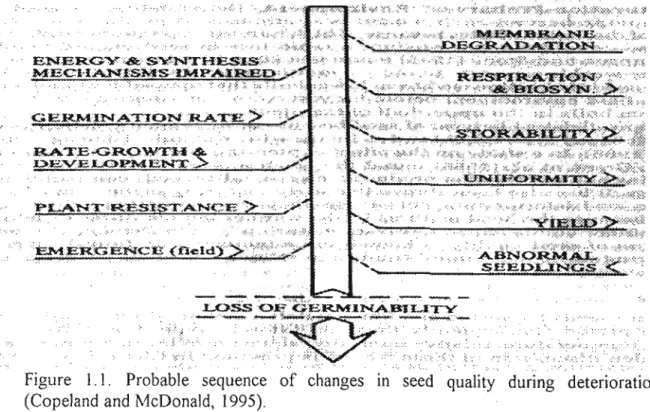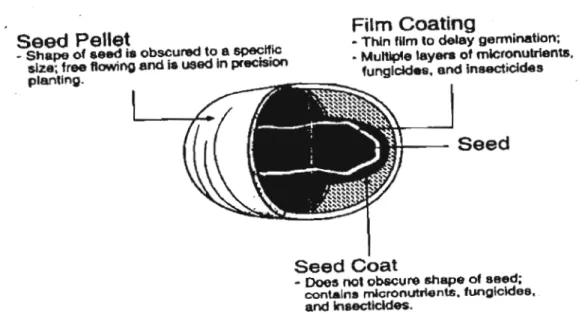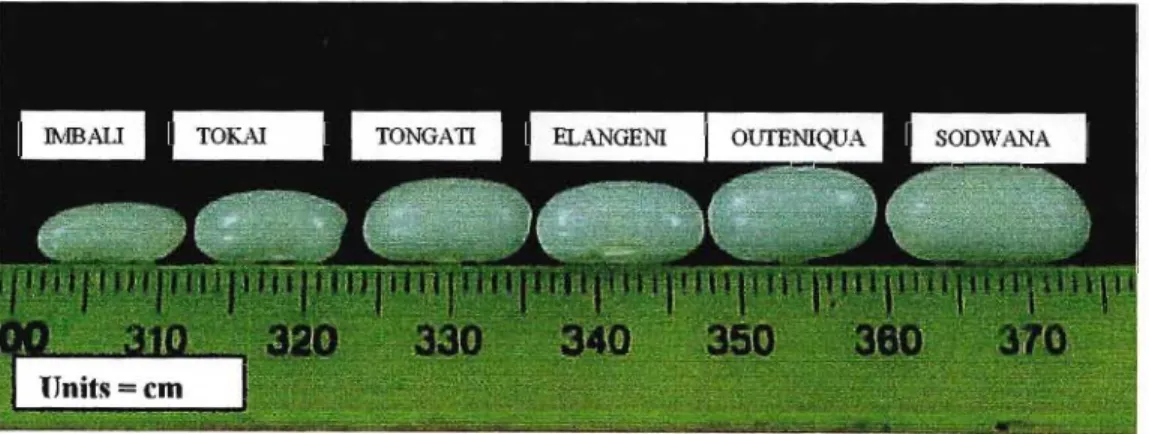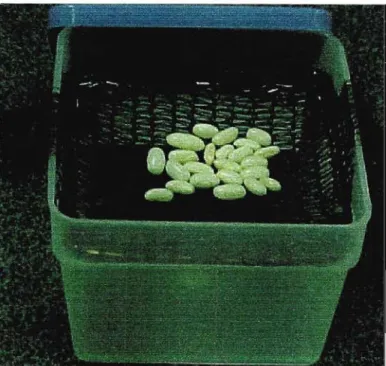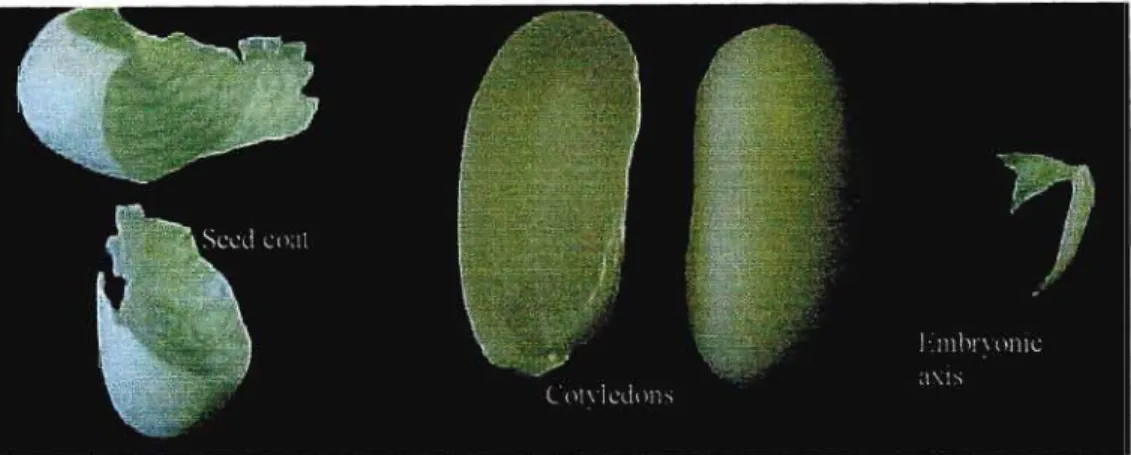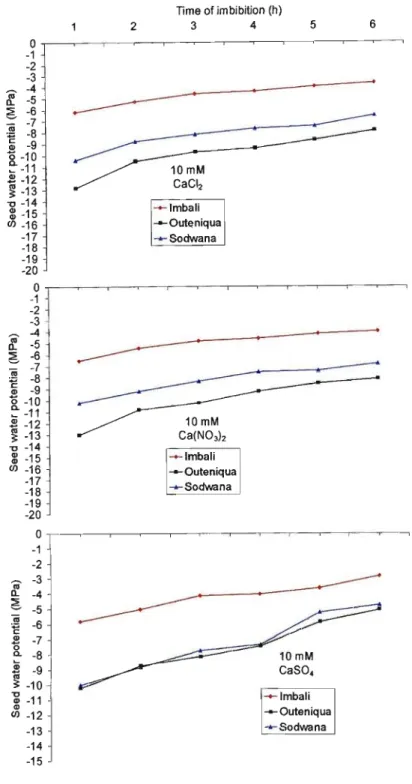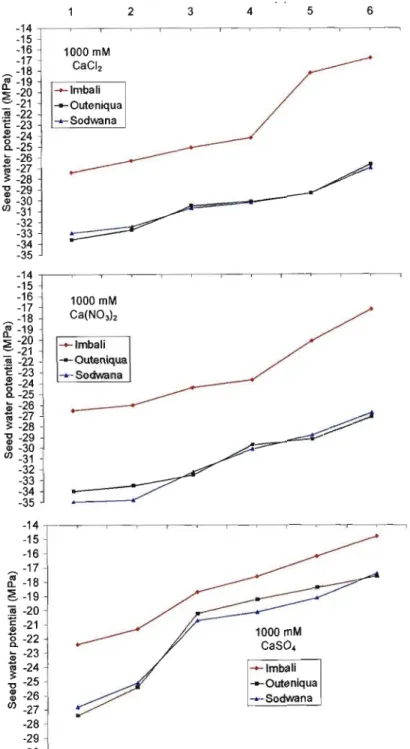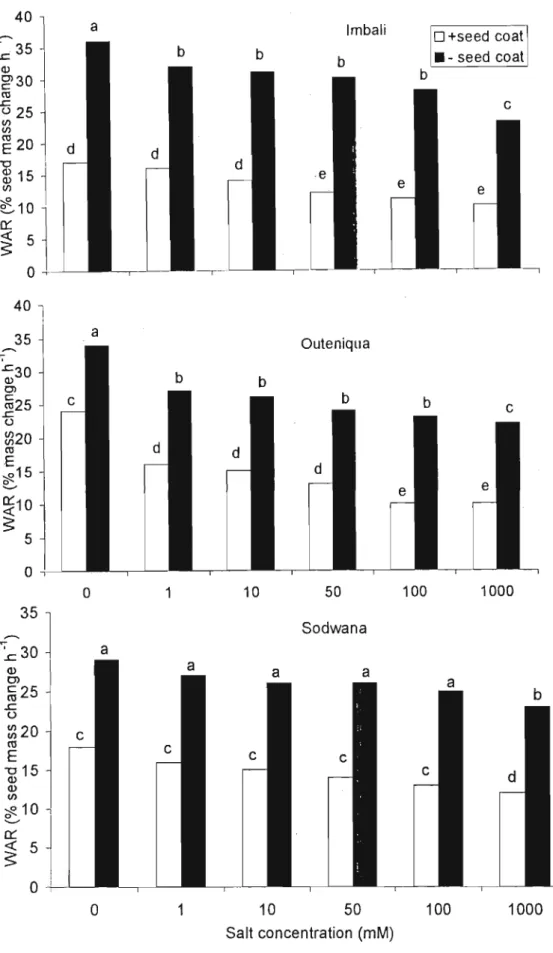The effect of calcium is related to the regulation of imbibition and the improvement of calcium content in the seed. Data points are averages of responses to CaCh, Ca(N03)2, and CaS04 during a6h uptake. Values with the same letter are not significantly different ( P =0.05). Note: + and - indicate the presence of and. Effect of different calcium salts on the height of green bean seedlings in 2001 (1st year) and 2002 (2nd year). Meanings that have the same letter.
Effect of seed calcium treatment on the reduction of cotyledon cracks in the parent and first generation seedlings. Effect of different seed calcium treatments (coating and priming) on the reduction of cotyledon cracking in parent and progeny. F 1) generation of green bean seedlings. Means the part of the. Effect of different salts on seedling dry weight (seedling dw) and cotyledon persistence (cot wet weight) in the Fl.
APPENDIX 3.2
APPENDIX 4.2
Results
As the six cultivars used in this study were genotypically characterized by a wide range of seed sizes (Figure 2.1), it was necessary to evaluate whether they also differed in imbibition rates. Changes in seed water potential of three cultivars (Imbali, Outeniqua and Sodwana) during imbibition in 10 mM salt (CaCh, Ca(N03)2 and CaSO4). Changes in seed water potential of three cultivars (Imbali, Outeniqua and Sodwana) during imbibition in 100 mM salt (CaCh, Ca(N03)2 and CaSO4).
Changes in seed water potential of three cultivars (lmbali, Outeniqua and Sodwana) during imbibition in 1000 mM salt (CaCh, Ca(N03)2 and CaSO4). Resistance to cotyledon cracking increased as salt molarity increased (Figure 2.7), but there was also a significant interaction between cultivars and molarities. Data represent means in response to three calcium salts (CaCh, Ca(N03hand CaSO4) during a 6-hour priming period. Means sharing the same letter are not significantly different (P= 0.05).
Calcium analysis using atomic absorption spectrophotometer (AA) showed that the cultivars absorbed different (P < 0.001) amounts of calcium after 6 h of imbibition in different calcium salts. Imbali and Elangeni contained the highest amounts of calcium, and Tongati the lowest (Figure 2.13). Increased salt concentration resulted in an increase in the amount of calcium taken up by the seeds (Figure 2.14), and a significant (P < 0.001) difference was observed between the three salts used.
Seeds absorbed the least amount of calcium from CaS04, whereas there was no significant difference between seeds ingested in Ca(N03)2 and CaC\z (Figure 2.15). There was also a significant (P < 0.001) difference between seed parts in terms of the amount of calcium absorbed, with the lowest amount found in cotyledons and the highest amount in the seed coat (Figure 2.16). Effect of applied calcium salt on the amount of calcium taken up by seeds after 6 hours imbibition.
The amount of calcium taken up by different parts of the seeds during 6 hours of ingestion in different calcium salt solutions.
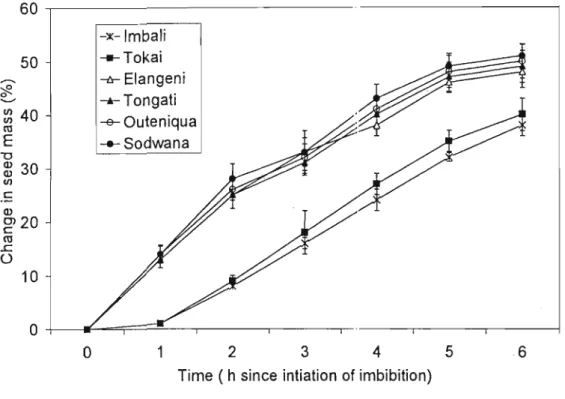
Discussion
The role of the seed coat in regulating the rate of water absorption and consequently the rate of cracking was clearly demonstrated by the significant increase in TVC in the absence of seed coats compared to when the seed coat was present. However, this was not expected to occur within 6 hours of imbibition. His evidence was indirectly determined in cotyledons of germinated seedlings, under field conditions (Chapter 3) and in first-generation seeds (Chapter 4). Judging by the reduced seed germination in response to high calcium osmolarity (Figure 2.I I), it is likely that the Ca2+- salts had some toxic effects on the seeds. Toxicity may have been more important in the embryo axis than in the cotyledons.
Cultivars with small seeds, which absorbed less water per unit time in the presence of the seed coat, also germinated better than cultivars with large seeds, which were characterized by earlier water runoff and more complete absorption of water after 6 hours of absorption. Occurrence of cotyledonal cracking in early beans and its relation to seed nutritional status.HortSci.snce. Transverse cotyledon cracking can have detrimental effects on pod production by impairing seed germination, delaying seedling emergence and reducing yield (Morris, 1971; Aqil and Boe, 1975).
The benefits of osmoconditioning (increased germination and physiological seed quality) were maintained in soybean seeds after up to six months of storage, but soaking in water followed by drying was detrimental to seed quality (Lucca et al. 1997b). Reducing electrolyte leakage improved yield, as seeds that leaked large amounts of electrolytes performed poorly at field emergence and seedling establishment (Min, 2001). In a previous study (Chapter 2), it was shown that preparing seeds in calcium osmotic allows sufficient time for water and calcium uptake.
Average cracks per plot across all three sites are presented for all variables determined separately in 200 I and 2002. Osmoprimed seeds had significantly (P < 0.001) more cracks than coated seeds (Figure 3.1) in 2001 and 2002 field experiments. the number of cracks per plot was observed with an increase in salt concentration (Figure 3.2). Cultivar performance in relation to the number of cracks observed on seedlings in the field in 200 I (year I) and 2002 (year 2). Salts showed a significant (P =0.05) effect on seedling height with CaS04 resulting in the tallest seedlings (Figure 3.10).
Most cultivars showed a significant decrease in yield in the second year except for cultivar Imbali.
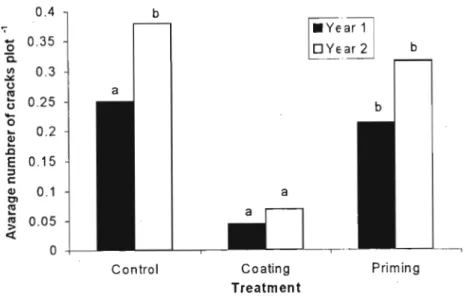
Discussion
Fast growth may also have contributed to the ability to resist the effect of pathogens and improved yield. Occurrence of cotyledon cracking in snap beans and its relation to nutritional status in the seed. In the USA alone, 25% of agricultural income losses are due to poor seed quality (Copeland and McDonald, 1995).
High seed moisture content results in the formation of ice crystals if the storage temperature is low (~ 0°C), and this promotes fungal growth at high temperatures (Copeland and McDonald, 1995). In addition to storage conditions, internal factors and genetic makeup of the seed also play an important role in the deterioration of a seed lot. The effect of treating parental seeds (see Chapters 2 and 3) with calcium on the first generation of seeds was determined. It was speculated that the effect of the calcium treatment would be persistent in the first generation as determined by reduced cotyledon cracking and improved seed quality.
Two cultivars, Sodwana and Tokai, which showed significant differences regarding seed and seedling quality in laboratory (chapter 2) and field studies (chapter 3) were selected to test the stability of calcium seed treatment in the first generation of seeds and seedlings. High performance liquid chromatography (HPLC) was used to determine the sugars in the same steep water with seeds used for mineral element analysis. No significant differences were observed between the two cultivars (Sodwana and Tokai) with respect to emergence in the offspring seedlings, however differences (P . <.00 I) were observed with the different salt concentrations.
The number of cracks observed was significantly reduced in the progeny sprouts compared to the parent seeds (Figure 4.10). Relationship between calcium salt concentration applied to green bean mother seeds and the number of cracks observed per pot in the first progeny seedlings. Performance of osmoprimed and coated green bean seeds with respect to cracking in first progeny sprouts. LSD = 0.03; P<0.05.
Effect of different salts on seedling dry weight (seedling dw) and cotyledon persistence (wet weight) in the FI generation.
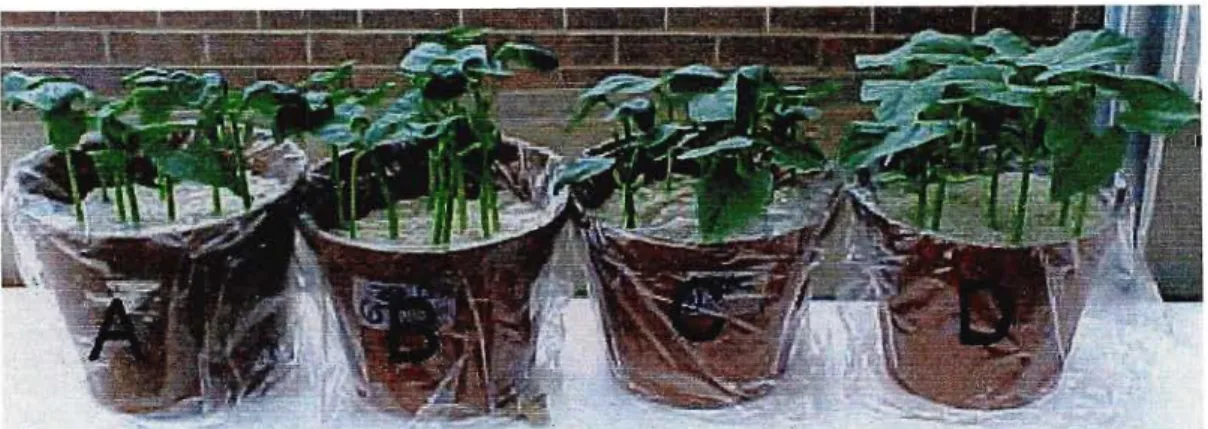
Discussion
Judging by measurements of steep water characteristics, cell wall integrity of seeds treated with calcium salts was also improved in the progeny. Thus, resistance to TVC was lost with seed coat color. In the present study, cultivars with white seeds were examined and found to differ in susceptibility to TVC (Chapters 2–4). Therefore, it is to be expected that genetic diversity, within populations, exists among the different legume cultivars examined for cotyledon crack in the studies preceding this one (Chapters 2 to 4).
Comparison of the three cultivars selected and examined in the laboratory (Chapter 2) (Imbali, Outeniqua and Sodwana) for susceptibility to cotyledon cracking (Imbali, Outeniqua and Sodwana), with regard to protein profiles, showed that Outeniqua and Sodwana (susceptible cultivars , see Figure 2.10) the same a common protein (- 20 KDa) that was not present in Imbali (TVC-resistant cultivar; see Chapters 2 and 3). The effect of seed coat permeability and water absorption rate was evident in the large-seeded cultivars, which tended to absorb water rapidly in the early stages of ingestion. Calcium seed treatment reduced the TYC of seedlings derived from direct seed treatment, under field conditions, and in the first progeny seedlings under greenhouse conditions.
Again, concentrations of 50 mM significantly reduced the number of cracks and did not have any negative effect on seedling emergence and establishment in the field. Laboratory and field results showed that increasing calcium salt concentration resulted in a decrease in the occurrence of cracks. Determining the protein profiles of the seeds treated with different salt concentrations may be an easier way to determine whether there were differences at the molecular level. as a result of calcium treatment. Current research has already shown that there are differences in the protein profiles of the different cultivars, but more research is needed into the effects of calcium. Identifying the proteins that represent variations will provide an important step forward in elucidating genetic differences.
More studies should be conducted to verify the stability of the calcium seed treatment in the first generation using more cultivars than those used in the present study. More understanding is required of what is happening to the seed as it takes up calcium during imbibition and seed coat, and where calcium is distributed in the cotyledons. These two studies confirmed that supplying seedlings with calcium in the form of foliar sprays increased the amount of calcium content in the seedlings.
Calcium seed treatments target the seed and improve the calcium content of parent seeds by reducing cracking in both parent and F 1 generations.
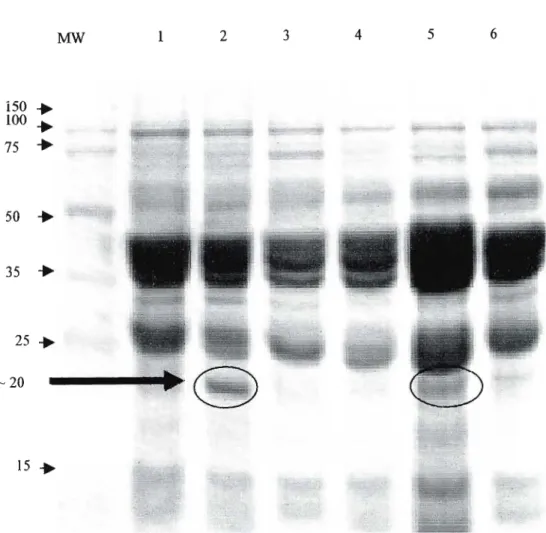
Locations of experimental sites (Harding, Inehanga and Pieterliiaritzburg)
Analysis of variance for cracks (TYC) in the presence of the seed coat under laboratory conditions. Analysis of variance for cracking (TVC) in the absence of the seed coat under laboratory conditions. Analysis of variance for seed mass change (TVC) in the absence of the seed coat under laboratory conditions.
